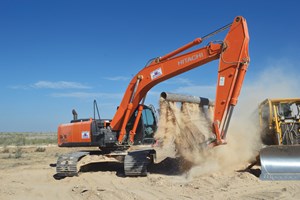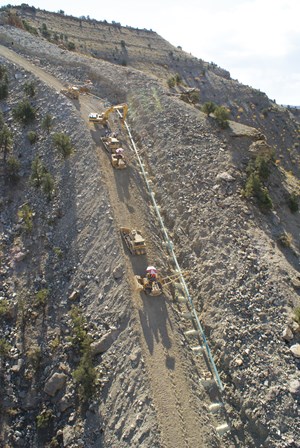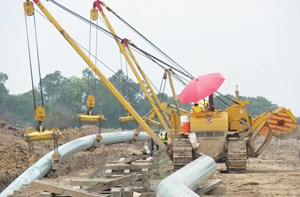November 2020 Vol. 75 No. 11
Features
Energy Pipeline Construction, Market Trends
By Jeff Awalt, Executive Editor
The COVID-19 crisis has dramatically affected oil and gas production and demand, leaving no midstream oil and gas markets untouched as drilling screeched to a halt, pipeline projects were sidelined and global storage neared capacity in a stark reversal of trends at the start of 2020.
As the pandemic continued to rage into the fourth quarter and economies around the globe sputtered to restart, projections seesawed week to week and the outlook for demand recovery remained hazy.
The International Energy Agency (IEA) predicted in July that producer supply cuts will help return global oil markets to more stable footing by the end of the year, with demand rebounding in 2021 by a record 5.3 MMbpd to 97.4 MMbpd, despite an estimated 7.9 MMbpd decline in 2020 to 92.1 MMbpd.
Earlier estimates had forecast a more severe impact, but oil demand during the second quarter bounced back more than many analysts expected. IEA, for one, revised its forecast upward by 400,000 bpd in July but warned of ongoing risks: “While the oil market has undoubtedly made progress, the large, and in some countries, accelerating number of COVID-19 cases is a disturbing reminder that the pandemic is not under control, and the risk to our market outlook is almost certainly to the downside.”
The U.S. Energy Information Administration (EIA) cautiously reset average oil price expectations higher in its July forecast while bracing for the potential impact of lingering – even elevating – numbers of coronavirus cases in some regions. It predicted average 2020 prices for West Texas Intermediate (WTI) at $37.55/bbl (+6.9 percent vs. June) and Brent crude at $40.50 (+6.5 percent). For 2021, it expects WTI to average $45.70 and Brent $49.70.
Natural gas has so far experienced a less severe impact than oil, but it has not been immune. “The record decline this year represents a dramatic change of circumstances for an industry that had become used to strong increases in demand,” said Fatih Birol, IEA’s executive director.
Worldwide natural gas demand this year is expected to fall by 4 percent, or 5.30 Tcf (150 Bcm) – twice the size of the drop following the 2008 global financial crisis, according to IEA’s “Gas 2020” report. For the full year, more mature markets across Europe, North America and Asia are forecast to see the biggest drops, accounting for 75 percent of the total decline.
Natural gas prices have remained low as reduced demand has so far outweighed lower production, but consensus estimates point to upward price pressure later in 2020. EIA forecasts the benchmark Henry Hub spot price will average $2.46 per MMBtu in the fourth quarter of 2020. In 2021, it expects lower production to push the average to $3.10.
In developed regions, demand for crude oil pipeline construction should continue to track upstream production trends, largely driven by U.S. shale and conventional upstream projects in the Middle East and Russia. Demand for natural gas pipelines, meanwhile, will be influenced by a more complex range of factors, many of which are region-specific.
Developing regions such as China and India have committed to expanding their natural gas import and distribution infrastructures as they wean themselves off coal, and low natural gas prices provide incentive for ongoing pipeline construction. But reduced economic activity, even in these faster-growing regions, has dampened demand, resulting in a supply glut that may slow the expansion of LNG export infrastructure elsewhere in the world.
North America
The global plunge in oil and gas demand abruptly halted a surge of pipeline construction activity in the United States, where operators were answering demand created by a decade of record-shattering shale production and soaring exports.
U.S. operators have scaled back or deferred crude oil projects to the tune of at least 1.5 MMbpd since the lockdown began to seriously impact oil prices and production in April. Announced delays include the Phillips 66/Plains All American Red Oak and Liberty pipelines and the Enterprise Products Partners Midland-to-Echo 4 pipeline. Phillips 66 Partners also deferred a final investment decision on its ACE Pipeline project and the planned expansion of its Sweeny Hub fractionation capacity.
“Midstream companies are somewhat reticent about canceling projects or announcing delays, so the number of such announcements has been limited,” notes Morningstar Analyst Sandy Fielden, who looks for projects that have either passed their planned start-up dates or are listed without completion dates in EIA’s pipeline database.
Based on those indicators, the list of impacted construction projects includes the 650-mile, Permian-to-Brownsville Jupiter Pipeline, Marathon’s 600,000-bpd Swordfish Pipeline in Louisiana and the Plains/Delek 150,000-bpd Red River expansion.
Legal and regulatory challenges to major pipeline projects have steepened the decline in construction activity. In July, Dominion Energy and Duke Energy canceled their long-delayed, $8 billion Atlantic Coast natural gas pipeline, a project that would have delivered Marcellus Basin natural gas to the U.S. Southeast. Earlier, Williams put its Northeast Supply Enhancement natural gas pipeline on hold after New York environmental regulators denied a key water permit and canceled the proposed Constitution natural gas pipeline from Pennsylvania to New York after years of opposition.
A plan to roughly double the capacity of the 570,000-bpd Dakota Access crude oil pipeline (DAPL) was proceeding through the approval process in early 2020, but the fate of both the expansion and the existing pipeline came into question in July when a federal court ordered it to be shut down and emptied due to a purportedly faulty environmental permit. Energy Transfer is appealing the order.
Construction of TC Energy’s Keystone XL crude oil pipeline was delayed by a court ruling, upheld by the U.S. Supreme Court in July, requiring additional environmental review. The Calgary-based company said it remains “fully committed” to the 830,000-bpd project and will look at alternatives if the U.S. permit is not reinstated, such as pursuing individual permits for different pipeline segments and route adjustments.
There was a silver lining to the U.S. Supreme Court ruling, however, as it also reinstated the U.S. Army Corps of Engineers’ fast-track permitting program known as Nationwide Permit 12 for other projects. That decision removed a roadblock that threatened to delay more than 70 pipelines across the United States and add up to $2 billion in costs, according to industry estimates.
Canada’s Supreme Court also made rulings in 2020 benefiting pipeline construction projects, including one that ended seven years of legal challenges to the Trans Mountain pipeline expansion. Now under construction, that project will triple the capacity of the 67-year-old pipeline from Alberta to the British Columbia Coast. Completion is slated for late 2022.
TC Energy’s Coastal GasLink pipeline also resumed construction in Western Canada after a positive ruling earlier in the year. The $5 billion (C$6.6 billion) project will move gas 416 miles from Northeast British Columbia to the Pacific Coast, where the Shell-led LNG Canada export facility is under construction.
Other notable projects still moving ahead in the United States include the 650-mile Wink-to-Webster Pipeline, a joint venture between affiliates of Exxon Mobil, Plains All American and MPLX. The pipeline will transport 1 MMbpd crude oil and condensate from the Permian Basin to the Texas Gulf Coast upon expected completion in early 2021.
Enbridge is pursuing state regulatory approvals to replace the U.S. portion of its Line 3 replacement project after completing the Canadian portion of the 1960s-era pipeline earlier this year. The $2.9 billion U.S. stretch would extend from North Dakota across Minnesota and Wisconsin. Farther east, EQM is proceeding with construction of its 300-mile, 2-Bcfd (56-MMcm/d) Mountain Valley natural gas pipeline, although its targeted completion date has been pushed to early 2021 and its estimated cost rose another 5 percent this year to $5.7 billion.
Whitewater Midstream, MPLX and partners secured funding in June to proceed with construction of Whistler Pipeline, a 500-mile natural gas project scheduled to commence operation in the third quarter of 2021. The project will add 2 Bcfd of capacity from the Permian Basin to the Agua Dulce area of South Texas.
Energy Transfer continues to target 2020 completion of its Sunoco Mariner East expansion project, although work was temporarily suspended in late March by a state government order halting business activity due to the coronavirus. The expansion will add 250,000 bpd to the system.
Africa
Oil remains the dominant fuel in Africa, but with nearly 500 Tcf of proven natural gas reserves, there is growing movement toward development of natural gas infrastructure primarily to expand its power generation capacity.
Abu Dhabi National Oil Company (ADNOC) said in June that a consortium of investors agreed to bring $10.1 billion in foreign direct investment for natural gas pipeline assets valued at $20.7 billion. Under the agreement, ADNOC will lease its interest in assets to ADNOC Gas Pipelines for 20 years in return for a volume-based tariff subject to a floor and a cap.
Nigeria National Petroleum Corporation (NNPC) started construction of the biggest natural gas pipeline in the country’s history – a $2.8 billion, 384-mile project from Ajaokuta to Kano. The 40-inch line will transport 3.5 MMscf/d from multiple gathering projects in southern Nigeria, resulting in the establishment of a connecting network between its eastern, western and northern regions.
Tanzania and Kenya are constructing a 345-mile gas pipeline between Tanzania’s Dar es Salaam and Tanga and on to Mombasa, in Kenya’s coastal city of Mombasa. The project, which is being developed under a contract by China Petroleum Technology and Development Corp., will meet the estimated gas demand of 50 MMscf/d in the two countries. Demand is projected to rise to 150 MMscf/d by 2035.
A group of 15 West African countries is studying the feasibility of extending the 420-mile West African Gas Pipeline, owned by the JV West African Gas Pipeline Co. (Wapco). Launched in 2010, the pipeline connects the Escravos-Lagos pipeline at Nigeria Gas Co.’s Itoki export terminal to Takoradi in Ghana, with laterals to points in Ghana, Benin and Togo.
A number of major African crude oil pipelines continue to languish, but there are signs of life. Construction began earlier this year in Niger’s Diffa region on a $7 billion China National Petroleum Corp. pipeline to deliver oil to the West African coast through neighboring Benin. The first phase of the 1,232-mile project requires an investment of $4 billion through 2021, according to the Associated Press.
Asia-Pacific
China continues to play a leading role in regional energy consumption and infrastructure construction, and there were high expectations for 2020 after it consolidated its midstream operations last year into a single, state-held company and opened access to foreign and private producers.
Consensus forecasts call for gas demand to rise 4–6 percent in 2020, down from an estimated 10 percent growth rate in 2019, while LNG imports are projected to grow by 4 percent this year compared with earlier expectations of 12–14 percent. But economic recovery appears sluggish even in those areas where the virus is all but eradicated – a pattern repeated in other growth regions of Asia – and projections remain fluid.
China’s COVID-19 infections peaked early, and pipeline work on some major projects restarted as early as February, including the 690-mile middle section of the China-Russia east-route natural gas pipeline. The middle section stretches from Changling County in the northeastern Jilin Province to Yongqing County in the northern Hebei Province, connecting with the north section that entered service last year. The middle section is scheduled for startup in late 2020.
India has emerged as a hotspot for natural gas pipeline construction in the region as it seeks to double the share of gas in its energy mix to 15 percent by 2030. To achieve this, companies are investing $60 billion in a network to expand LNG import facilities in the west and build pipelines connecting them to every state before the current government’s term ends in mid-2024, according to India’s energy minister.
One major project already well underway by India’s biggest gas utility, Gail Ltd, is the 1,660-mile Urja Ganga pipeline project, which will connect the eastern states of Bihar, West Bengal, Jharkhand and Odisha, with a capacity of 16 MMscf/d– an amount equal to roughly 10 percent of India’s total daily consumption. Gail hopes to bring the system online by the end of this year.
A northeast gas grid is also under construction to connect eight states in northeastern India, a region bordering Bhutan, Myanmar, Bangladesh and China, with completion expected in 2023. Earlier this year, India approved funding for a $774 million gas pipeline in the region.
In addition to the gas buildout, Indian Oil, Bharat Petroleum and Hindustan Petroleum formed a consortium last year to construct the 1,700-mile Kandla-Gorakhpur liquefied petroleum gas (LPG) pipeline. The project, scheduled for completion in 2024, will source LPG from west coast import terminals and supply bottling plants along the route.
Europe
Declining domestic production and increasing natural gas demand have made Europe a natural target for pipeline gas and LNG exporters, prompting an uptick in infrastructure construction in recent years.
Gazprom has targeted Europe with major natural gas pipelines across the Baltic and Black Seas, including TurkStream, which is already flowing, and Nord Stream 2, which has only a short stretch of construction and some U.S. sanctions standing in the way of its completion.
Concerns over Europe’s growing reliance on Russian gas has added motivation for some countries to build new infrastructure that diversifies their supply sources. Polish and Danish gas grid operators Gaz-System and Energinet are moving ahead with Baltic Pipe, a 528-mile bidirectional project that gives Denmark, Poland and Sweden direct access to Norway’s North Sea gas and moves Poland closer to its goal of becoming eastern Europe’s gas hub.
Bulgaria is scheduled to complete the bidirectional Greece-Bulgaria Gas Interconnector (ICGB) by the end of this year, ending its total dependence on Russian gas and helping to diversify supplies in southeastern Europe. The $268 million, 113-mile link will have initial annual capacity of 105 Bcf.
ICGB will carry mainly Azeri gas via the Trans Adriatic Pipeline (TAP), which also is scheduled for completion by the end of 2020. The 710-Bcf per annum TAP will bring natural gas to Italy and onward to Adriatic countries, including Greece and Albania
Middle East
The Middle East has continued to build out its natural gas infrastructure following large discoveries in the Eastern Mediterranean during the past decade and the growing availability of low-priced LNG. Some governments have also focused on the construction of new crude oil pipelines, although the pandemic has slowed progress of at least one major project.
The Iraqi oil ministry in December announced the completion of its pre-qualification process for construction of an estimated $18 billion oil pipeline that would carry 1 MMbpd of oil from Basra through the Jordanian port of Aqaba and across the Red Sea to Egypt. The first phase of the project would be constructed in Iraq across a 435-mile stretch between Rumaila and Haditha. Developers delayed the May 2020 deadline for technical offers for the project, known as the Iraq Jordan Export Pipeline (IJEP), due to COVID-19.
In neighboring Iran, President Hassan Rouhani launched a 620-crude oil pipeline from Goreh to Jask in June, noting its strategic value as a secondary export route “whenever the Strait of Hormuz faces danger.” About 20 MMbpd of oil passes through the narrow strait, making it vulnerable to military blockades.
Russia & CIS
Russia’s growth strategy for natural gas pipeline exports has targeted Europe since the 1950s, but it is expanding its flow of gas to the east by targeting China’s growing energy demand.
Last year, state-owned giant Gazprom completed construction of the 1,865-mile, Power of Siberia pipeline, with capacity to transport 1.34 Tcf per year across Eastern Russia to China. Recently, Gazprom began a feasibility study for a Power of Siberia-2 project, which could deliver another 1.77 Tcf of gas per year across Mongolia to China.
But Europe remains squarely in its sights, and Gazprom is determined to overcome U.S. sanctions that have so far prevented completion of its Nord Stream 2 pipeline across the Baltic Sea to Germany. Those sanctions forced All Seas to halt pipelaying in December with only 75 miles remaining. In early July, Denmark gave permission to use pipelaying vessels with anchors to complete the final stretch of the pipeline in Danish waters, removing a key obstacle.
Bulgaria’s prime minister said in early June that the 295-mile Balkan Stream extension will be ready by the end of 2020 despite construction delays due to the COVID-19 crisis. Balkan Stream will carry up to 706 Bcf per year of mainly Russian gas from TurkStream to Bulgaria, Serbia and Hungary.
Despite their cooperation on TurkStream, relations between Turkey and Russia have been patchy in recent years, and that – along with depressed LNG prices – may have encouraged Turkey to deliberately prolong a recent maintenance outage on the Blue Stream pipeline.
South & Central America
Proven reserves of natural gas in South and Central America represent only a tiny fraction of global reserves, but pipeline infrastructure in the region is insufficient to meet growing demand.
Brazil’s state energy research office EPE said last September that its growth projections justify construction of 16 new pipelines, although their status is uncertain as the country faces one of the world’s most severe coronavirus outbreaks. Among the recommended pipelines, five would be offshore; among others, the largest would be a 563-mile project connecting Sao Carlos to the capital city, Brasilia. Further east, the state of Bahia has already begun construction on the final section of the 190-mile, $100 million Southwest Gas pipeline. •







Comments